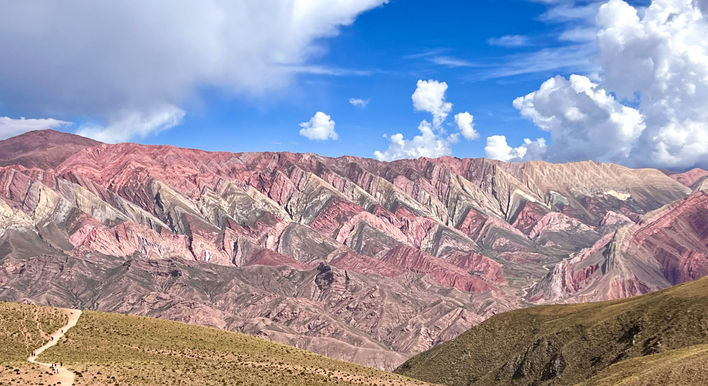Tomorrow I should be starting a two day trip into the Quebrada de Humahuaca with four guests from India, but instead we are going in completely the opposite direction: south to Cafayate in the Salta wine region.
A tour we think you'll love
For more than two weeks now, Jujuy has been aflame with protest against changes to the province’s constitution.
The most popular way of protesting in Argentina is to camp out on main roads, whether in the middle of Buenos Aires or in other cities.
It can be incredibly effective at drawing attention to local issues, as it immediately creates a captive audience of furious and frustrated but occasionally sympathetic and curious bystanders.
It’s also completely illegal according to federal legislation, but this being Argentina, most of the time law enforcers stand by and watch.
In the 15 years I’ve been running private Argentina tours, these roadblocks have been occasional irritants, but they have often proved an opportunity for the guests to chat to the locals and take a few photos, before we continued on our way. Rarely did we have to wait for longer than 15 minutes to be let through: but the current multiple road protests are delaying motorists for several hours at a time.
On one occasion, talking to protesters near Purmamarca, I discovered they had built homes on the other side of the Rio Grande from the main road (probably without permission, but that’s a can of worms to open another day): they simply wanted a footbridge so their kids didn’t have to wade through the river on their way to school during rainy season.
Fair enough, it seemed to me: the chaos they provoked in just a few hours led to the hurried visit of a dignitary from Jujuy government: pacification, and hey presto, a new bridge was constructed within a few months.
Back when I first started doing tailor-made tours in Argentina in 2008, our main roadblockers were the Tupac Amaru group, run with an iron fist by an imposing woman called Milagro Sala.
She is currently under house arrest serving a 13 year jail sentence imposed in 2019 (due to ill health she has hardly spent any time in a jail cell), for fraudulent diversion of 60 million pesos destined for social housing (and this was when the peso was still worth something: at the time of her conviction it was 37 pesos to the dollar!)
After lengthy appeals, the verdict was ratified by the Supreme Court in December last year, but despite this, she’s still regarded as a political prisoner by many activists, and even once serious newspapers like Pagina 12.
Perhaps inevitably, Milagro Sala has been linked to current protests, with claims that two people she ironically claimed were “tourists” staying at her home in the exclusive lakeside suburbs of the capital San Salvador de Jujuy were the heads of Tupac Amaru branches in the north eastern provinces of Misiones and Corrientes.
The current protests began on Friday June 16th, on the eve of the long weekend marking the anniversary of the deaths of generals Guemes and Belgrano, two heroes of the War of Independence, and they make the Boston tea party look like… well, a tea party. (Happy Independence Day to our US followers, by the way.)
Early that morning, Jujuy’s provincial government, with memories of the Tupac Amaru days, approved a reform of the constitution specifically prohibiting protests blocking public roads.
Other items on the agenda which provoked the ire not just of extreme opposition figures like Sala, but many moderate voters, include changes to land rights, though these were later withdrawn from the proposed bill.
The protests came on top of months of strikes over pay by teachers both in Jujuy and Salta, which earned pretty much unanimous public support.
It’s perhaps no coincidence that, in election year, the Radical governor of Jujuy Gerardo Morales is the running mate of one of the main opposition Presidential candidates Horacio Larreta, current Mayor of Buenos Aires city, and he’s predictably got into a Twitter shouting match with the President Alberto Fernandez which has only served to inflame the situation.
“We’ve had a terrible weekend, with many tourists in Jujuy. It’s been very difficult, but we’ve tried, in some way, despite the roadblocks, to offer all the services,” Monica Choque, President of the Jujuy Association of Travel & Tourism Agencies said when the protests began.
As I write, 18 days later, access to our regular tourist hubs of Tilcara and Uquia along Route 9 to La Quiaca on the Bolivan border are obstructed: and Purmamarca, famous for its Seven Coloured hill, and the gateway to the Salinas Grandes salt flats, is also blockaded… as is Susques, further along the main road to San Pedro de Atacama in Chile.
Even Salta tour companies like mine are affected, as we can’t operate two of our most popular trips, Essential Humahuaca and Salt & 7 Colours.
There are 12,500 beds awaiting tourists in Jujuy, and I had trouble finding three of them even booking a month in advance for a trio of French visitors… now we may have to cancel, go to Plan B and head south instead.
In an interview with local newspaper El Tribuno today, Jujuy tourism minister Federico Posadas estimated a loss of 200 million pesos daily (US$400,000) during the July holidays, directly caused by the road protests.
“We are talking about more than 25,000 families who live from tourism in a province which since 2015 until today is the one that has grown most in terms of tourism in all Argentina. Everything we’ve achieved is disappearing in a few weeks.”
A fortnight ago, tourists were taken by surprise by the protests: the trouble now is they are voting with their feet, directly cancelling their reservations for July holidays and going somewhere else.
- thanks to Edgardo Valera and Telam news agency for the photo.






